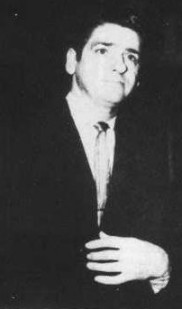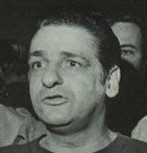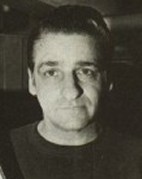

Introduction
From June 1962 to January 1964 a mysterious murderer known as the 'Boston Strangler' held the women residents of Boston in fear for their lives as he claimed 13 victims in a nineteen-month reign of terror. He would talk or break his way into his female victims apartment then strangle the victim to death usually with something from her own clothes, this would then be knotted up into a bow to mark his deadly signature. This page is a documentation of his life and crimes.
Profile

Name - Albert DeSalvo.
AKA - The Boston Strangler, The Mad Strangler, The Phantom Strangler, The Measuring Man, The Green Man.
DOB/DOD - 3 Septemeber 1931 - 25 November 1973.
Family - Father 'Frank', Mother 'Charlotte', 2 Brothers, 3 Sisters, Wife 'Irmgard', Daughter 'Judy', Son 'Michael'.
Residence(at Time of Murders) - Malden, Boston, Massachusetts. USA.
Murder Type/Practices - Serial Killer / Rapist.
Method/Weapons Used - Strangulation, Stabbing, Bashing / Hands, His Victims Clothes, Knife.
Organization - Mixed.
Mobility - Stable.
Victim Vicinity - Boston.
Murder Time Span - June 1962 - January 1964.
Victim Type - Old/Young Women Living in an Apartment.
Victims - Anna Slesers (Died 14 Jun 1962), Mary Mullen (Died 28 Jun 1962), Nina Nichols (Died 30 Jun 1962), Helen Blake (Died 30 Jun 1962), Ida Irga (Died 19 Aug 1962), Jane Sullivan (Died 20 Aug 1962), Sophie Clark (Died 5 Dec 1962), Patricia Bissette (Died 31 Dec 1962), Mary Brown (Died 9 Mar 1963), Beverly Samans (Died 6 May 1963), Evelyn Corbin (Died 8 Sep 1963), Joann Graff (Died 23 Nov 1963), Mary Sullivan (Died 4 Jan 1964) (+?).
The Beginning
Albert DeSalvo was born on the 3 September 1931, son of Frank DeSalvo, a labourer and plumber, and his wife Charlotte. The DeSalvo family was very poor and lived in a rundown apartment in Chelsea, a poor working class area of Boston. Frank DeSalvo was an alcoholic who physically abused his wife and children. At a young age Albert was sold into slavery with him and his two sisters sold off to a farm for nine dollars until they escaped months later. In order for their family to survive Frank DeSalvo taught his children to steal, which ranged from shoplifting to robbery and then breaking and entering. Albert's father finally left the family in 1939 with his mother divorcing him in 1944.
It is also evident that Albert was exposed to sex early in life, his father often brought prostitutes home and made his children watch as they had sex. Being in a poor area Albert sold himself to homosexuals around the community; he had his first sexual experience when he was about ten, experiencing such things Albert DeSalvo had an unusual sexual appetite that would later drive him to kill.
Fresh out of school in 1948 Albert joined the army and was stationed to occupied Germany where in Frankfurt he met a middle class catholic girl named Irmgard whom he later married. He brought Irmgard back to the USA with him in 1954, where he was then posted to Fort Dix. During his stay at Fort Dix his daughter Judy was born in 1955.
In 1956 DeSalvo left the army with an honourable discharge, it was claimed that he had sexually molested a nine-year old girl but charges had never been proceeded with. He returned to Chelsea, in Boston, with his family but then later moved to Malden, another suburb of Boston, where their son, Michael was born.
In the late 1950's Albert turned to breaking and entering, even though he had a job and home. He was arrested twice and both times got a suspended sentence. It was around this time that Albert's rejection of him by his wife got to him and he started his career as the Measuring Man. He got the the idea from a TV show where a photographer auditioned women who wanted to be models by taking their measurements. DeSalvo took to preying on young female students, introducing himself as a representative of a model agency and if they agreed he would take their measurements, clothed or naked. Sometimes DeSalvo's nature allowed him to seduce the woman, other times he would take their measurements then leave promising them they would be signed up by but this was never followed up with. DeSalvo never assaulted the women and the police received only a few complaints about the follow up not happening.
In 1961 DeSalvo was arrested by the police for breaking and entering, he spent 11 months in prison and was released in 1962, it was then that he turned to murder...
The Murders
On Thursday the 14 June 1962 at about 7pm Juris Slesers arrived at his mother, 55-year-old Anna Slesers, apartment at 77 Gainsborough Street in Boston. Upon knocking on the door he received no answer, thinking that maybe she couldn't hear him he waited thirty minutes until quite concerned he knocked the door down. When he entered he could not find his mother and the draws in her bedroom had been left open. He then went into the bathroom where he discovered the body of his mother, she was wearing a housecoat that had been left open at the front, so that she was naked from the shoulders down. The blue cord of her housecoat was tied around her neck in the shape of a bow. Juris Slesers immediately phoned the police and the homicide division police arrived just after 8pm.
From the police inspection they concluded that an intruder entered the apartment in an attempt to rob it(from the opened up drawers which contents had been disturbed), but upon finding Ms Slesers he felt an urge to strangle her. There was no rape but her body had been sexually molested. Although robbery was thought to be the motive nothing appeared to be taken, a valuable gold watch and other items had been left in their place. The method of entry was not also clear, there was no sign of a break-in and it was thought that the shy woman who kept to herself would not open the door to anyone particulary as she was wearing her bathrobe and did not have her dentures in. The police took to questioning more than sixty people but could not produce any leads in this bizarre case.
Two weeks later, on the 30 June 1962, the strangled body of 68-year-old Nina Nichols was discovered in her apartment. Like the Slesers murder Ms Nichols had been strangled with two of her own nylon stockings which was then knotted into a bow around her neck. Her housecoat had been pulled up to her waist exposing her naked body which had aslo evidently been sexually molested. The apartment also appeared to have been rummaged through with bags being torn open and items scattered about, but nothing was taken, a $300 camera and other objects had been left in their place. The method of entry was also a mystery - no sign of a break in and Ms Nichols was not known to associate with any men.
With two virtually identical murders in the space of two weeks the Boston Police Commissioner, Edward McNamara, held a conference of department heads on Monday the 2 July 1962. Before the conference had even ended, the police received news of a third strangling.
The body of 65-year-old Helen Blake was discovered in her apartment at 73 Newshall Street in Lynn, several miles north of Boston. Much like the the other murders her body was half naked and had not been raped but sexually molested. She had been strangled with her own nylon stocking with a bra looped through it. The bra straps had been knotted around her chin in the form of a bow. Her apartment was also the same as the others, searched through but nothing was stolen. An autopsy on the body revealed that Helen Blake had been killed a few days ago, on the 30 June, the same day when Nina Nichols had been killed.
The police were now aware that they had a repeat murderer out there, a stranger killer(the term serial killer was not coined until the mid 70's) with an obsession for strangulation. More action was taken on the case with rounds of suspects being checked and more detectives being assigned to the case. An emergency hotline number was established in the media of the case - DE 8-1212 and was active 24 hours daily. It was clear that police commissioner Edward McNamara was being hard pressed to solve this case.
On the 21 August 1962, 75-year-old Ida Irga had been found strangled in her apartment at 7 Grove Street in Boston's West End, from an autopsy it revealed she had been strangled on the 19 August. Much like the other murders this one was different in one way - the placing or posing of the body in a weird sexual position(this was another hallmark in DeSalvo's signature).
The female community of Boston was now living in fear. Women put iron bars on their windows and added locks and other devices to their homes. Other women sought weapons or guard dogs. With the media hysteria and women being cautioned to safety it would be thought that this would make the Boston Strangler's chance of killing much harder, yet he killed more women.

On the 30 August 1962 the strangled body of 67-year-old nurse, Jane Sullivan, was discovered in her apartment on 435 Columbia Road, Dorchester. The Autopsy showed that she had been killed earlier - on the 20 August, just one day after the murder of Ida Irga.
The Boston Strangler was now changing his pattern of murder. His next victim was Sophie Clark who was murdered on the 5 December 1962. Sophie Clark had been killed like the other women but she was 20-years-old, was black, did not live alone, and she had been raped.
On the 31 December 1962 the Strangler raped and murdered Patricia Bissette, a 23-year-old secretary who shared an apartment in the Back Bay area of Boston. The police were puzzled to why the Strangler had covered her body. An autopsy revealed that she had been one month pregnant.
The Boston Strangler struck again, this time on the 6 May 1963, his victim - Beverly Samans, a 23-year-old graduate student from Cambridge. She had been raped and was believed to have died by stab wounds to the throat although the killer had strangled her.
The police were far from able to solve this case. The modus operandi changed frequently and they had little to no clues on the killers identity. Their psychological profile of the killer also did not fit expectations. While thousands of people and suspects were being questioned, and sex offenders being checked, the Boston Strangler was still on his rampage.
The next victim was 58-year-old divorcee Evelyn Corbin who was strangled on the 8 September 1963. She seemed to be a lonely woman who made her living by working in a factory.
One day after the assassination of American president John F. Kennedy, on the 23 November 1963, the Strangler killed Joann Graff, a designer and sunday school teacher, in the Boston suburb of Lawrence. As the nation was in mourning on that day the media described the killer as the most ruthlessly brutal one in every way.
The eleventh official murder and final strangling took place on 4 January 1964. The murderer had killed 19-year-old Mary Sullivan, a secretary who had moved into the shared apartment(the murder scene) in Beacon Hill just three days before she was to be strangled. Her dead body had been placed in a sexual position on her bed(posing) and appeared to have been violated. The signature bow around her neck had been made with a stocking and two scarves. Between the toes of her left foot the killer had left a Happy New Year's card which had not been written on. Detectives also found a tiny amount of silver tin foil(which is used to wrap film) which suggested that the killer could of photographed his handywork.
Modus Operandi
Date |
Area |
Victim |
Age |
| 14 June 1962 | Back Bay | Anna Slesers | 55 |
| 28 June 1962 | Back Bay | Mary Mullen | 80 |
| 30 June 1962 | Greater Boston | Nina Nichols | 68 |
| 30 June 1962 | Lynn | Helen Blake | 65 |
| 19 August 1962 | West End | Ida Irga | 75 |
| 20 August 1962 | Dorchester | Jane Sullivan | 67 |
| 5 December 1962 | Back Bay | Sophie Clark | 20 |
| 31 December 1962 | Back Bay | Patricia Bissette | 23 |
| 9 March 1963 | Lawrence | Mary Brown | N/A |
| 6 May 1963 | Cambridge | Beverly Samans | 23 |
| 8 September 1963 | Salem | Evelyn Corbin | 58 |
| 23 November 1963 | Lawrence | Joann Graff | N/A |
| 4 January 1964 | West End | Mary Sullivan | 19 |
The Police
Two weeks after Mary Sullivan had been killed Attorney General Edward W. Brooke Jr assigned the Attorney General's Office of the Commonwealth of Massachusetts, headed by Assistant Attorney General John S. Bottomly, to take over the Boston Strangler case.
The first thing Bottomly did was gather all the information from the 5 police departments involved in the investigation and combine it all - this resulted in a 37,500 page report(some of the police departments had been keeping information from each other - in fear of the media and in some sense of competition). The information was then filed onto a computer.
There seemed to be only one real witness to the Stranglers identity. On the 18 February 1963 a 29-year-old German waitress opened her apartment to a man who said he was there to fix a gas leak. The woman was still coping with the effects of a sleeping pill but she let the man in anyway. As soon as she turned away he leaped on her and attempted to strangle her. Struggling on the floor she bit into his hand to get free, he let go and she screamed, alerting people nearby, the man then ran off. The frightened woman was unable to give a good description of her attacker.
The police had been on the case for more than 19 months and were no closer to solving the murders. It was then suggested that they enscribe the help of international psychic investiagtor Peter Hurkos, who had been credited around the world for helping police solve 27 murders in 17 countries. Hurkos arrived in Boston in late January of 1964 and immediately set out to help solve the case.
Hurkos displayed his psychic abilities to police by giving them mental images of the crime scenes and descriptions of the possible killer. He also sometimes went into trance like states where he would talk to victims. Some things he talked about were only known to police. Then one day Hurkos gave a physical description of the killer and police followed it up; the suspect man was investigated by police since he had fit Hurkos' description in every way but there was many points that could not fit the man to the crimes and he was released. Giving them no help at all Hurkos left the country.
Even more desperate then ever the police doubled the reward to ten thousand dollars. They also re-evaluated the crimes and made new assumptions - such as there being two killers involved, and that they could be homosexual woman haters seing that the victims lived near gay areas.
It was not until March of 1965 did they catch their man.
The Capture
For nine months after the Mary Sullivan murder, Albert DeSalvo went on a series of sexual assaults, which gave him the persona of the Green Man(because DeSalvo always wore green work trousers). The sexual assaults were carried out over a large area including Massachussets, Conneticut, Rhode Island and New Hampshire. His methods from being the Strangler to the Green Man changed; he would break into the womans door by slipping the lock and then he would tie the woman to her bed at knife point, then he would sexually assault them, although sometimes he would apologise and leave before doing so. He did not murder any of his victims in this series of 300 sexual assaults.
One of his victims identified him as the Green Man from police records of DeSalvo being the Measuring Man. DeSalvo was arrested on 6 November 1964 and was sent to Bridgewater State Hospital for observation, then he was transferred to Cambridge Prison where his mental state deteriorated. He was then re-committed back to Bridgewater in February 1965 as mentally ill, there he would await trial for the Green Man crimes.
At Bridgewater DeSalvo met another inmate, 33-year-old George Nassar, who was pending trial for a violent murder. DeSalvo did alot of boasting, mainly about the way he sexually dominated women. One day in March of 1965 DeSalvo told Nassar of how he had killed 13 women as the Boston Strangler. Nassar contacted his lawyer - Lee Bailey, and told him that DeSalvo was willing to talk to him(Nassar was most likely interested in the $110,000 reward). Bailey was reluctant at first but agreed to interview DeSalvo for the Strangler murders. On 4 March 1965 Lee Bailey telephoned Detective Lieutenant Donovan and asked for some questions for a man that was claiming to be the Strangler, Bailey just wanted to have the questions so he could know if the man was telling the truth. On the same day Bailey went to Bridgewater and interviewed DeSalvo.

Bailey turned on a tape recorder and asked DeSalvo about the murders. DeSalvo went into great detail of how he had killed the women. He drew sketches of the women's apartments, the circumstances that took place and the big, floppy bows he would tie around their necks. He also told of how he had killed two other women that the police didn't credit him with - Mary Brown, who was beaten and stabbed in her Lawrence apartment on 9 March 1963, and 80-year-old Mary Mullen who died of a heart attack in his arms on the 28 June 1962. DeSalvo's descriptions of the murders were flawess. Bailey was certain that DeSalvo was the Strangler, he then gave the tape recording of the interview to Detective Lieutenant Donovan. Donovan then contacted the Attorney General's office.
The Boston Strangler detectives now had their man, but with this confession there was no evidence to convict him. DeSalvo left no fingerprints and there was no witnesses except for a German Waitress who proved unable to identify her attacker. Assistant Attorney John Bottomly and other detectives interrogated DeSalvo again, all through the spring, summer and autumn of 1965, this time with more questions at hand(they agreed not to use this evidence against him).
The End
The case against convicting DeSalvo of murder was eliminated when the prosecution said that they were no longer willing to allow DeSalvo to confess pleading insanity. So without a confession and no evidence the prosecution had no case against him and could not proceed with a trial. It was also at this time that John Bottomly resigned because of a feud with the Attorney General.
DeSalvo still faced a trial for the Green Man crimes which had alot of evidence against him. Knowing that he would never be freed from prison, he wanted to be judged insane and committed to a mental institution, so that he could recieve psychiatric help. DeSalvo's new lawyer, Lee Bailey, was faced with a very difficult challenge, to prove that DeSalvo was not guilty by reason of insanity at the time of the Green Man crimes.
On the 30 June 1966 Albert DeSalvo went to a pre-trial hearing at the Middlesex County Courthouse, East Cambridge, to be assessed for his competency to stand trial. The charges were armed robbery and indecent assault. At no point was the Strangler case to be in this trial. On the 10 July Judge Horace Cahill judged that DeSalvo was competent to stand trial. DeSalvo was remanded without bail to Bridgewater Hospital until the trial would begin.
The trial started six months later on 9 January 1967, at the Middlesex County Superior Court. The charges against DeSalvo was 10 counts of indecent assault and armed robbery, for which he pleaded not guilty by virtue of insanity to. At the case the jury heard the stories from the victims of DeSalvo and other damning evidence. Bailey's defence included psychiatrists testifying to DeSalvo's mental sickness. On the 18 January 1967 the jury retired to consider their verdict. They took 3 hours and 45 minutes to return a verdict of guilty on all charges. Judge Moynihan sentenced DeSalvo to a life term, to be carried out at Bridgewater Hospital.
DeSalvo's family returned to Germany as he faced life at Bridgewater, which was more than a prison than a hosptal. At an attempt for people to notice his cry for psychiatric help DeSalvo and two other prisoners escaped from Bridgewater on 24 February 1967, at 6 am. After opening their cell doors with a made-up key they climbed down an unfinished elevator shaft and then scaled a 12 foot wall by mounting scaffolding against it. The two other prisoners were found in a nearby cocktail bar 36 hours later. Shortly after and with a huge Boston panic DeSalvo walked into a clothes store and telephoned Lee Bailey to give himself up. DeSalvo's two brothers were arrested for aiding and abetting in the escape.

DeSalvo was transferred to Massachussets Walpole maximum security prison shortly after the escape. Six years later, on the 25 November 1973, Albert DeSalvo was found dead in his prison cell. He had been stabbed through the heart six times in what authorities said was a prison brawl, although his killer was never caught.
One year after DeSalvo's trial Hollywood came up with two movies - 'The Boston Strangler' and 'No Way to Treat a Lady'. The Boston Strangler had Tony Curtis in the lead role and the film tried to recreate the real events and show DeSalvo's personality. No Way to Treat a Lady is a black comedy with Rod Steiger playing the murderer. There has also been a few other films about DeSalvo.
Conclusion
In Lee Bailey's closing defence statements at the Green Man trial he argued that the society should keep such a rare specimen of a killer in a mental hospital so he can be subject to an intense study. Bailey was ignored but in the following years the serial killer was not to become such a rare occurence in the US.
Go Back
